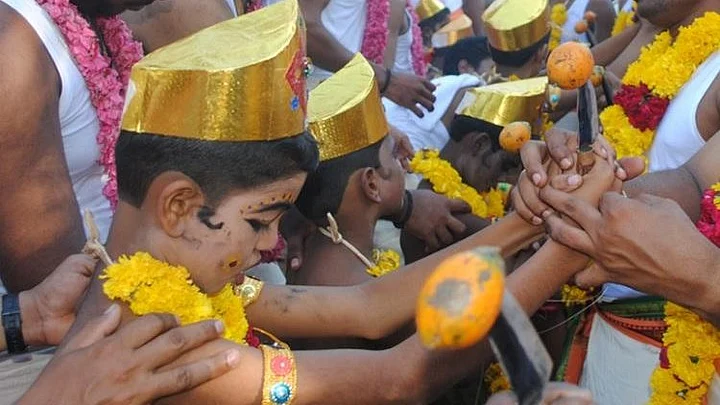It is a controversial ritual involving minor boys that was banned by the Kerala High Court in 2017.
But according to sources, the Chooral Muriyal ritual at the famed Chettikkulankara Devi temple in Kerala's Alappuzha district was conducted on Thursday despite the ban and around 12 groups participated in it.
What is ‘Chooral Muriyal’?
The ritual is part of ‘Kuttiyattam’, which means ‘sacrifice’ for the temple deity, goddess Bhadrakali.
Normally, rich families in the neighborhood adopt boys in the age group of 8-14 years for a fee and after a week of adhering to vows, the boys become “offerings” to the goddess.
Their faces painted white, a thick flower garland around their necks and a paper-crown on their heads, the ‘adopted’ boys are made to take part in the ritual.
A golden coil is inserted through the skin of their midriff. The boys "readied" for the Chooral Muriyal dance towards the temple in a procession on the occasion of Bharani festival that falls in the Malayalam month of Kumbham.
After dancing before the deity, the golden coil is taken out and the boys along with the drops of blood on the coil are offered to the goddess.
On Thursday, at the end of the 10-day festival at the Devi temple that began on the day of Shivarathri, Chooral Muriyal was reportedly performed.
A source who was part of the ritual confirmed to TNM that as many as 12 groups performed the banned ritual.
Kerala State Commission for Protection of Child Rights (KeSCPCR) had in 2016 banned the practice of Chooral Muriyal and the HC had later in 2017 upheld the ban. However, a petition filed by Sreedevi Vilasam Hindumatha Convention, a devotee outfit, had sought a review on the ban. Disposing off their petition, the HC refused to stay the ban, posting the case for a future date.
Chettikkulangara Devi temple authorities were, however, not available for comment. When TNM reached out to the temple authorities on Wednesday, they had maintained that Chooral Muriyal was only being conducted in households and not at the temple itself.
However, a dance instructor who trains the young boys told TNM that he had trained several boys this time too. He likened the ritual to piercing an ear.
"I trained two out of the 13 groups. But since I respect the court order, I did not pierce the golden coil on their bodies," he said.
What is The Controversial Ritual?
Chooral Muriyal is a centuries-old ritual that is performed to thank the goddess for fulfilling one's wish. According to the instructor, Chooral Muriyal and Kuthiyottam originated after Bhadrakali killed Darika, an asura. When Bhadrakali's anger failed to subside even after killing Darika, her father Shiva lay on the floor so the former could walk over him.
Bhadrakali stamps on Shiva and is immediately overcome by guilt for having stepped on her father. To relieve Bhadrakali of her sadness, Shiva transforms into a child. On seeing the child, Bhadrakali becomes happy and forgets her anger. The bhoothaganas accompanying Bhadrakali are elated and begin to dance.Instructor
Over the years, the ritual began to be performed at the temple, where in, young boys are "offered" to the goddess to bring her joy and the dance that the boys perform is symbolic of the dance performed by the bhoothaganas.
This ritual is not a sacrifice. Many people term it as bali (sacrifice) but it isn’t so. The boys are offered to the goddess as a gesture of gratitude, something that will make her happy.Instructor
Who Are The Boys Involved in The Ritual?
If families who want to take part in the ritual do not have young boys, then it is perfectly acceptable to "buy" boys from other families, argues the instructor.
There are several reports that point to the fact that young boys are "sold" by their families to take part in the festival.
However, the instructor insists that the boys are "offered" and not "sold."
During the course of the ten-day festival, the boys live in the house of people who "adopt" them.
T Sudheesh, a journalist with Deccan Chronicle who has been consistently covering the ritual, says that usually these children come from socially and financially backward families. The rich who want to please the goddess spend a lot of money to adopt the boys, he says.
For a poor family, getting Rs 50,000 or Rs 1 lakh in return for letting their child perform the ritual, is not a big thing. But the rich do not let their own children perform. The poor families who end up offering the children, however, fail to see how the rich are exploiting them. It is a complicated situation, where religion and faith is heavily influencing the lives of the people.T Sudheesh
Sudheesh adds that the children from poor families, who end up taking part in the ritual, are later termed as unlucky.
The ritual in which the golden coil with the child’s blood is offered to the goddess signifies that the child has been offered to the deity. After this, the kids are looked down upon as a bad symbol.T Sudheesh
(This article has been published in an arrangement with The News Minute.)
